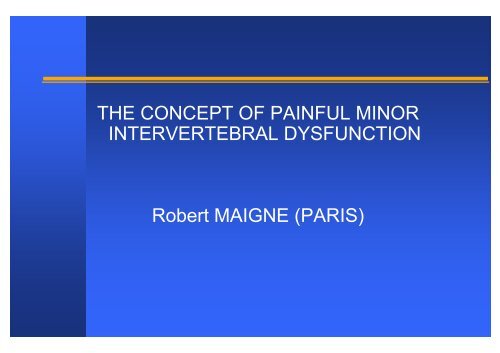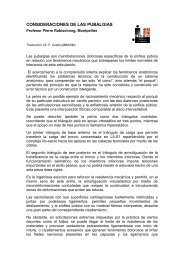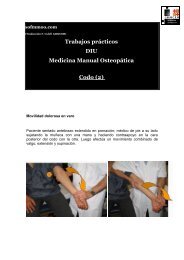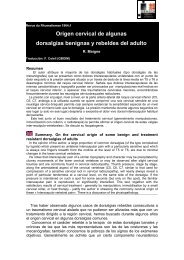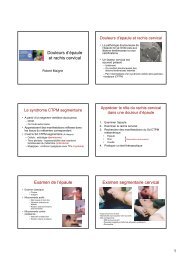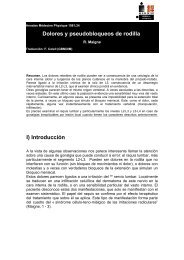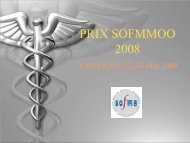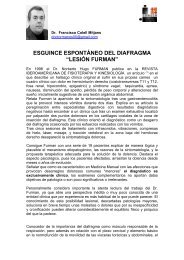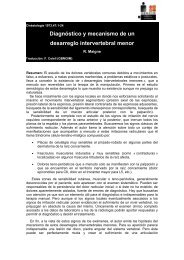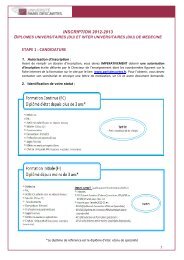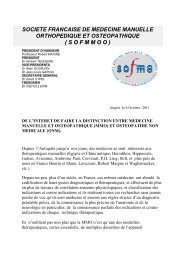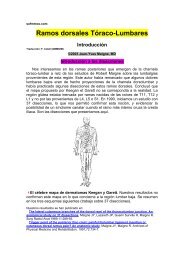The concept of painful minor intervertebral dysfunction ... - sofmmoo
The concept of painful minor intervertebral dysfunction ... - sofmmoo
The concept of painful minor intervertebral dysfunction ... - sofmmoo
Create successful ePaper yourself
Turn your PDF publications into a flip-book with our unique Google optimized e-Paper software.
This theory is open tocriticism Clinical assessment <strong>of</strong> hypomobility is not areliable and reproductible test Hypomobility is frequent in osteoarthriticcadaveric vertebral joints– <strong>The</strong>re is no evidence that it may be a source <strong>of</strong> pain– Hypomobility could be regarded as a protective mechanismagainst overuse <strong>of</strong> a degenerated joint
SEGMENTAL EXAMINATION Pressure on thespinous process Transversepressure againstthe spinousprocess Longitudinal frictionon the facets joints Pressure on theinterspinous ligament
SEGMENTAL EXAMINATION Pressure on thespinous process Transverse pressureagainst the spinousprocess Longitudinal frictionon the facets joints Pressure on theinterspinous ligament
SEGMENTAL EXAMINATION Pressure on thespinous process Transverse pressureagainst the spinousprocess Longitudinal frictionon the facets joints Pressure on theinterspinousligament
SEGMENTAL EXAMINATIONSource <strong>of</strong> errors Superficial tenderness <strong>of</strong>the spinous process Interspinous acute bursitis
SEGMENTAL EXAMINATIONSource <strong>of</strong> errors Pressure <strong>of</strong> a sensitive orcellulalgic skin over thespinous process
SEGMENTAL EXAMINATIONSource <strong>of</strong> errors Pressure <strong>of</strong> a cellulalgic skinor tender taut muscularbands against the z-joints
Pain Originating from a VertebralMotion Segment Can Be Due ToMany Causes (benign or not)Some are more or less easily recognizable– Disc herniation– Acute synovitis <strong>of</strong> the Z-jointsOthers would be only recognizable with sophisticatedinvestigations– Facet blocks– Discography + MRI<strong>The</strong>se tests– Are positive in less than 50% <strong>of</strong> the cases (Schwarzer et al, 1995)– Are not applicable in routine daily practice
Pain from a Motion Segment Can Be DueTo Many Causes Segmental examination focuses the intereston the <strong>painful</strong> segment Special attention must be paid on thissegment Depending on the clinical and the radiologicalcontext, further investigations may benecessary
Painful Minor IntervertebralDysfunction (MID, R. Maigne)<strong>The</strong> diagnosis <strong>of</strong> Painful MID is evoked1 - When the segmental examination is positive2 - When the pain is considered as common3 - Whether the X-Rays films are normal or shownon significant degenerative changes
PAINFUL MINOR INTERVERTEBRALDYSFUNCTION (R. Maigne)MID : Is the result <strong>of</strong> trauma, efforts, bad postures,repeated micro-traumas... Is not linked to any neurological deficit or X-Rayabnormality <strong>The</strong> diagnosis <strong>of</strong> MID is purely clinical It is based on segmental examination
Painful Minor IntervertebralDysfunction (R. Maigne)In the framework <strong>of</strong> common painsyndromes, the most frequent causes<strong>of</strong> segmental <strong>dysfunction</strong> are:– "Painful Minor Intervertebral Dysfunction"(MID)– Disc lesions– Synovitis <strong>of</strong> zygapophyseal joints
Painful Minor IntervertebralDysfunction Painful <strong>minor</strong> <strong>intervertebral</strong> <strong>dysfunction</strong> may beconsidered as a self-sustaining sustaining sprain <strong>of</strong> thevertebral segment <strong>The</strong> Painful MID can be active or latentactive or latent. <strong>The</strong>signs <strong>of</strong> MID are permanent in chronic caseseven between attacks
Painful Minor IntervertebralDysfunctionPainful <strong>minor</strong> intervetebral <strong>dysfunction</strong> appears tobe the common denominator <strong>of</strong> a great number<strong>of</strong> vertebral pain– directly– or by intermediary <strong>of</strong> reflex manifestationsthat may be determined in the correspondingmetamere : Segmental Vertebral Cellulo -Teno-PeriosteoPeriosteo-MyalgicSyndrome(R. Maigne)


